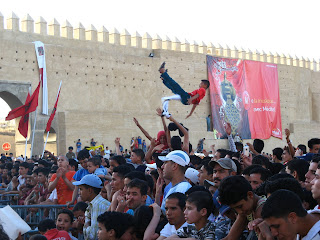The festival ran from Wednesday, June 18th through Sunday, the 22nd: I was only able to attend two nights, Thursday and Sunday, as I wanted to attend the Maroc Hit Parade in Rabat on the 21st. (This just goes to show how many festivals there are in Morocco; many festivals overlap one another).
On Thursday, I attended a performance by H-Kayne, probably the most popular hip-hop act in Morocco. It was definitely a fun show, although, as a drummer, I always am a little jaded while watching a concert that does not have a live drummer. As they say, “Drum machines don’t have souls.”
Sunday was the biggest day of the festival, anyway, with performances by Darga, Barry, Band of Gnawa, and of course, Hoba Hoba Spirit. The whole afternoon and evening was a blast. Hoba’s performance was incredible: it was the hometown show for the band, so there was an even higher level of energy than normal. Because I was leaving Morocco the next morning, it also was the last Hoba Hoba Spirit concert I attended, making it a very special experience for me.
Throughout the course of this year, I have been exposed to many new wonderful musicians. Without a doubt, I have seen more talent in Morocco than any of the other countries I have conducted the research in.
When friends ask me, “What is Moroccan music like?” I cannot help but roll my eyes. Moroccan music is absurdly diverse: because North Africa is teeming with so many different cultural influences, the music of Morocco cannot be easily categorized. But, to answer that nagging question, Moroccan music can sound like traditional Arabian music or classical Berber music or classical Andalusian (Spanish) music or typical French music or tribal West African music…or, it can sound like a hybrid of all, or some, of those influences!
Because contemporary artists have such a deep musical pool to draw from, bands like Hoba Hoba Spirit and Darga emerge with a very unique, but very grounded, sound. I think it is so neat how modern bands employ traditional elements.
To think of the evolution of Moroccan music, it is so incredible to remember that a genre of music, like gnaoua, originated as the music of West African slaves brought to Morocco. The rhythms of gnaoua can be heard in the music of Hoba Hoba Spirit. These same rhythms even constitute the backbone of blues music. Very, very cool, indeed…
In terms of my personal experience in Morocco, I have only the fondest memories of country. I would highly recommend anyone and everyone to travel to Morocco; it is one of the most fascinating, and beautiful, corners of the world. If you are a music aficionado, definitely visit Morocco anytime from the middle of May to early July, as there are a plethora of festivals. Perhaps the most interesting aspect of the “music season” in Morocco is that almost all of the performances are free: it is so commendable that the King and other private institutions have financed so many great festivals.
Lastly, I must say a big, BIG thank you to Amine Chabi and Adil Hanine for all their help. I could write a list of a hundred names of individuals that assisted me throughout my field research, a testament to the tremendous level of hospitality throughout the country…
Apologies for the delays on the website; more to come on my adventures in Cuba. Stay tuned…





















































